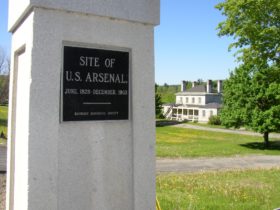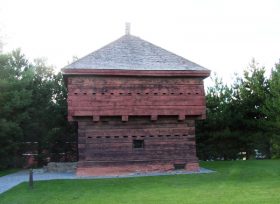It was the nation’s only war declared by a state and the nation’s only bloodless war. Its roots were planted in the Treaty of Paris of 1783 ending the Revolutionary War. With inaccurate maps and uncertainty about with local river was the French named St. Croix River, the treaty language left the British termed “Disputed Territory” of about 12,000 square miles vulnerable to conflict in what was known as the Northeast Boundary Dispute.
The War of 1812 enhanced the British concern over its “Grand Communication Route” that linked London, Halifax and Quebec City. However, a portion of that route ran through the “Disputer Territory.” It was an important strategic asset that the British were inclined to fight for in what could have been the third American British conflict in fifty years.
When John Baker received a land grant in the territory from the State of Maine, the British arrested him and took him to Fredericton where he was convicted of sedition in 1828. In the same year the U.S. federal government established a garrison in Houlton with four companies of the 2nd United States Infantry. The U.S. also began construction of the Kennebec Arsenal in Augusta in preparation for the use of force in protecting the U.S. boundary claims.
The simmering dispute boiled over in 1837 when New Brunswick officials arrested a Maine state land surveyor who was conducting a census in the northeastern regions of the state which were also claimed by New Brunswick. (See map.)
Maine citizens were outraged. Because the federal government took no action, the Maine legislature authorized $10,000 for the defense of the disputed territories. A military road (roughly following the current U.S. Route 2 to Macwahoc, then U.S. Route 2A to Houlton) was authorized to aid in the movement of troops from Bangor to Houlton. Another, later to be known as the Airline, was authorized to link Bangor with Calais, but was never completed.
Fork Knox, in Prospect, was built in response to the potential conflict to secure the Penobscot River from British ships. Further north and near the “front lines” Fort Kent was built in 1838-1840.
A note in the cataloging record of papers of The Maine Military Road (see below) states the following:
The Governor of Maine ordered the Maine Militia to construct a military road to Haynesville from the Plummer/Prouty Turnpike as a result of the Northeast boundary dispute which culminated in the Aroostook War of 1839.
Included in this collection are three original contracts by which Col. James Thomas hired Jonathan Plummer, Hiram Prouty and Patrick Lee to construct the road and a letter dated March 22, 1839 from N. G. Norcross to Major General Hudson concerning the appointment of a sutler for the Kennebec Division and the construction of a fort on the frontier.
An expedition of 200 men led by state land agent Rufus McIntire arrested several Canadians, including the New Brunswick warden of the disputed territories, James McLaughlin. New Brunswick officials,now upset,arrested several of the Maine volunteers including McIntire.
Edward Kent was Governor during the “war,” and one of the fortifications built in anticipation of hostilities, Fort Kent, was named in his honor.
In 1839 the Maine legislature, furious over the arrest of McIntire, then appropriated $800,000 and raised a militia of 10,000 men to defend the northern territories. Patriotism and flag waving swept the entire state, and other states were promising support. No longer able to ignore the dispute, Congress authorized $10 million and raised a 50,000-man militia to defend Maine’s claims.
The only fighting of this war occurred in a Houlton barroom where both British and American troops were drinking. When someone offered a toast to Maine’s success, a brawl broke out that resulted in several black eyes and bloody noses.
Battle was avoided when Daniel Webster negotiated a peaceful withdrawal and new boundary with Alexander Baring, Lord Ashburton. The treaty became known as the Webster-Ashburton Treaty and established Maine’s current northeastern boundary in 1842.
Additional resources
Aroostook war: historical sketch and roster of commissioned officers and enlisted men called into service for the protection of the northeastern frontier of Maine, from February to May, 1839. Augusta, Me. Kennebec Journal Print. 1904.
Burrage, Henry S. Maine In The Northeastern Boundary Controversy. Portland, Me. Printed for the State. 1919.
Campbell, W. E. (William Edgar). The Aroostook War of 1839. Fredericton, N.B. Goose Lane Editions. c2013. Catalog notes: New Brunswick military heritage series; 20. Includes bibliographical references and index. Issued also in electronic format. Co-published by: Gregg Centre for the Study of War and Society. [Maine State Library; University of Maine, Orono, Special Collections; University of Maine at Fort Kent and at Presque Isle]
Correspondence and documents relative to the North Eastern boundary. 1825-1840. [Maine State Library]
Documents Relating To The Disputed Territory. Maine Legislature. House (19th) [Augusta] Smith & Robinson, Printers. [1839?]
Gallatin, Albert, 1761-1849. A Memoir On The North-Eastern Boundary: In Connexion With Mr. Jay’s Map. New York. Printed for the [New York Historical] Society. 1843.
The Maine Military Road. 1830-1839. [Maine State Library]
Merk, Frederick. Fruits Of Propaganda In The Tyler Administration. (with the collaboration of Fredrick Lo Merk.) Cambridge. Harvard University Press. 1971.
Sprague, John Francis. The North Eastern Boundary Controversy And The Aroostook War. Dover, Me. The Observer Press. [1910?].
Stadig, Rita B. Aroostook War: The Little Lake Fort Is Located. Soldier Pond, Me. The Author. c1994.




For a different view of the Aroostook War crisis, have a look at “The Aroostook War of 1839” (Fredericton: Goose Lane Editions, 2013)
Thanks for noting “the different view.” I will obtain a copy to consider expanding this article’s content.